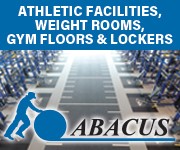The expectations for the design, cleanliness, functionality, and safety of all types of commercial facilities have undergone a transformative experience in just a few years. Restroom design strategies, technology, and materials that were progressing in popularity just ten years ago have been fast-tracked, in large part, by the coronavirus pandemic and growing consumer demand. Just as 9/11 changed air travel and the iPod transformed how we listen to music, the coronavirus pandemic will forever change public bathroom design and how people perceive—and respond to—restrooms’ cleanliness and safety.
In particular, public restrooms in educational settings—shared spaces that are typically high-traffic, high-use, and high-touch—have drawn a significant amount of infection control consideration. Not only do restrooms contain multiple touchpoints necessary for activating restroom fixtures and doors, but they have also recently come under the microscope for indoor air quality issues, largely due to the dreaded “toilet plumes” that contain airborne contaminants such as Covid-19.
Seventy-eight percent of American adults say they are more conscious about germs as a result of the coronavirus, according to the Healthy Handwashing Survey conducted by Bradley Corporation. Further, in school buildings, the top three places that high school students are most concerned about coming into contact with germs are: school restrooms (63%); classrooms (50%); and the cafeteria (42%).
Hybrid Learning and Building Design
In the broader sense, higher education learning institutions are looking for ways to meet students’ needs and adapt to hybrid learning experiences. Sixty-eight percent of students and seventy-four percent of educators want a hybrid learning model that combines both in-person and remote learning methods, according to 2022 Gensler’s Design Forecast. Therefore, elevated, user-focused designs are being employed by higher education to attract and retain students when they are present in campus settings.
As students look to schools not just as places of learning but as places to feel safe, engaged, and included, there will be an ongoing emphasis on educating and catering to individual students and their well-being. To adapt to the needs of students as Covid rates fluctuate, universities are integrating the concept of health and wellness into campus designs. In restrooms, specifically, they are paying closer attention to details in these spaces, such as how clean they look and smell, whether they are stocked with supplies, how easy they are to navigate without touching surfaces, their overall functionality and convenience, and how private and safe they feel.
Gender-Neutral Restrooms
Another increasingly important upgrade is creating access to gender-inclusive restrooms. As students and campuses advocate for a more inclusive and open climate, there are now more than one hundred and fifty colleges and universities that have added gender-inclusive restrooms on campus, and more have them in the works, according to the Education Advisory Board. While the most efficient way to create gender-inclusive restrooms is to convert existing single-occupancy restrooms, a number of institutions are now opting to build multi-stall gender-inclusive restrooms.
Either way, for these gender inclusive restrooms to serve their purpose, they must be easily accessible from all areas of the campus. Additionally, many state and local building codes determine the number of men’s and women’s plumbing fixtures a given building needs without regard to gender-inclusive spaces. Therefore, converting a men’s or women’s restroom into a gender-inclusive one may take a building out of compliance. Keeping an updated inventory of all restrooms on campus can help avoid renovating restrooms that are required to meet the applicable standards.
Improving Operational Efficiency
Increasing operational efficiency also ranks high for restroom upgrades. Over-stretched maintenance staffs are on the lookout for restroom products, technologies, and features that optimize maintenance, cut costs, and make their jobs easier. Restroom products with maintenance indicators, IoT connectivity, A/C power (vs. batteries) and vandal-resistance features considerably improve and simplify maintenance. While expectations and performance specs for campus washrooms are high, the performance of today’s products, materials, and layout strategies have followed suit.
Hands-Free Technologies
Touchless technology eliminates touchpoints, reduces germ accumulation on restroom surfaces, and is in high demand by users because, simply, they don’t want to touch things in restrooms. Seventy-six percent of high school students believe it is important that school restrooms have touchless fixtures, while eighty-four percent of adults echo that sentiment for access to touchless fixtures in all public restrooms.
In fact, Americans view touch-free technology as the number one feature that makes them feel safer from germs in restrooms. Touchless features are also Americans’ most requested improvement in restrooms. More cleaning/restocking takes second place.
The top touchless restroom features considered most important to users are faucets, soap dispensers and flushers. “Under any circumstance, using touchless fixtures helps to inhibit the spread of germs in restrooms and buildings,” says medical microbiologist Michael P. McCann, Ph.D., professor of biology, Saint Joseph’s University. “The more we avoid restroom touchpoints, the healthier and easier our operations will be.”
Touchless Fixtures and Maintenance
In just the past few years, the mechanicals used in sensored technology have been significantly improved. While some older touchless models include sensors that deliver spotty soap and water activations, today’s designs incorporate advanced sensing technology to ensure continuous and reliable washing, From an operational efficiency standpoint, today’s touchless fixtures are easier to keep clean, maintain, and service than manually activated fixtures. In addition to less soap “misfires” and splotches leftover in and around the basin, touchless fixtures and accessories help reduce waste since they only activate when a user is present and can be programmed to dispense a pre-determined amount of soap, water, or paper towels. In addition, automated technologies can be easy to retrofit into a current restroom space.
All-in-one handwashing fixtures designed with integrated soap, faucet, and hand dryer help water containment in the handwashing basin. Specifically, the hand dryer is engineered to work with the basin to keep water in the basin and prevent water from dripping from hands onto the user, walls and floors, which is maintenance intensive and can cause slips and falls.
Touchless high-speed hand dryers can also help guard against excessive amounts of paper towels littered on the restroom floor. If using paper towel dispensers, planners can opt for models constructed of ABS high-impact material, which is not easily damaged and features reliable touch-free activation and jam-free operation.
Germ-Resistant Surface Features
For sinks, smooth and nonporous materials with seamless construction like solid surface and natural quartz look beautiful, help prevent bacteria and mold accumulation, and are highly durable and difficult to vandalize. They can be easily cleaned, disinfected, repaired, and reused, plus they have a longer lifecycle. There are no seams, so there are no unsightly gaps or grout lines to detract from the handwashing space or to accumulate dirt. These sustainable materials are also cast-formed so they may be specified in many attractive shapes.
Another benefit of cast-formed basins is that they can accommodate multiple users at one time—a big plus for campus restrooms that service a high volume of users during peak times. Some multi-user handwashing models have the look and feel of individual sinks, while others have increased space between the handwashing areas to allow for social distancing while washing hands. Other single-station units combine a taller sink with a lower sink in an interesting wave design to comply with ADA requirements.
For soap and faucet fixtures, PVD coatings are not only a more sustainable way to finish metals than traditional electroplating, but they are also inherently antimicrobial. These popular and attractive finishes are produced with physical vapor deposition (PVD), an advanced process that creates a molecular bond to the fixture, creating a resilient coating that will not corrode or fade. Some manufacturers offer a variety of PVD finishes to complement any restroom design.
Space Planning and Traffic Flow
European restroom models with gender-neutral layouts—stalls forming a perimeter around communal washing stations with open circulation—are gaining popularity in commercial restrooms. A parallel can be drawn between the benefits of a restroom planned to be gender-neutral and planned to address Covid/germ concerns.
Many colleges and universities are ahead of the game in facilitating restroom traffic since campus restrooms have already adopted open design elements like doorless, S-curved entryways, which encourage one-way traffic and minimize cross-traffic.
Placement of handwashing features can also support user traffic. As mentioned earlier, all-in-one handwashing models with smart soap, faucet, and dryer keeps handwashing elements in one space so there’s no need to walk across the restroom in search of soap or water, reducing cross-traffic and water dripping from hands onto floors and walls.
Optimizing restocking and refills is another way to enhance traffic flow. For example, soap refills for multi-user sinks can be messy and time intensive. A new soap dispenser design features a multi-feed system that is a maintenance game changer. The system is ergonomically easy to refill and supplies soap to up to six dispensers at once, reducing downtime. It also features a smart sense system with LED light indicators to display low soap and battery, also making maintenance more efficient.
Today’s restroom equipment manufacturers offer a host of products designed to meet the evolving needs of college and university campuses. As campuses rethink their restrooms, they can consider many strategies for making these spaces more hygienic, maintainable, and functional. As the pandemic stretches on, these new priorities that provide users with a healthy and safe public bathroom experience are likely here to stay.










